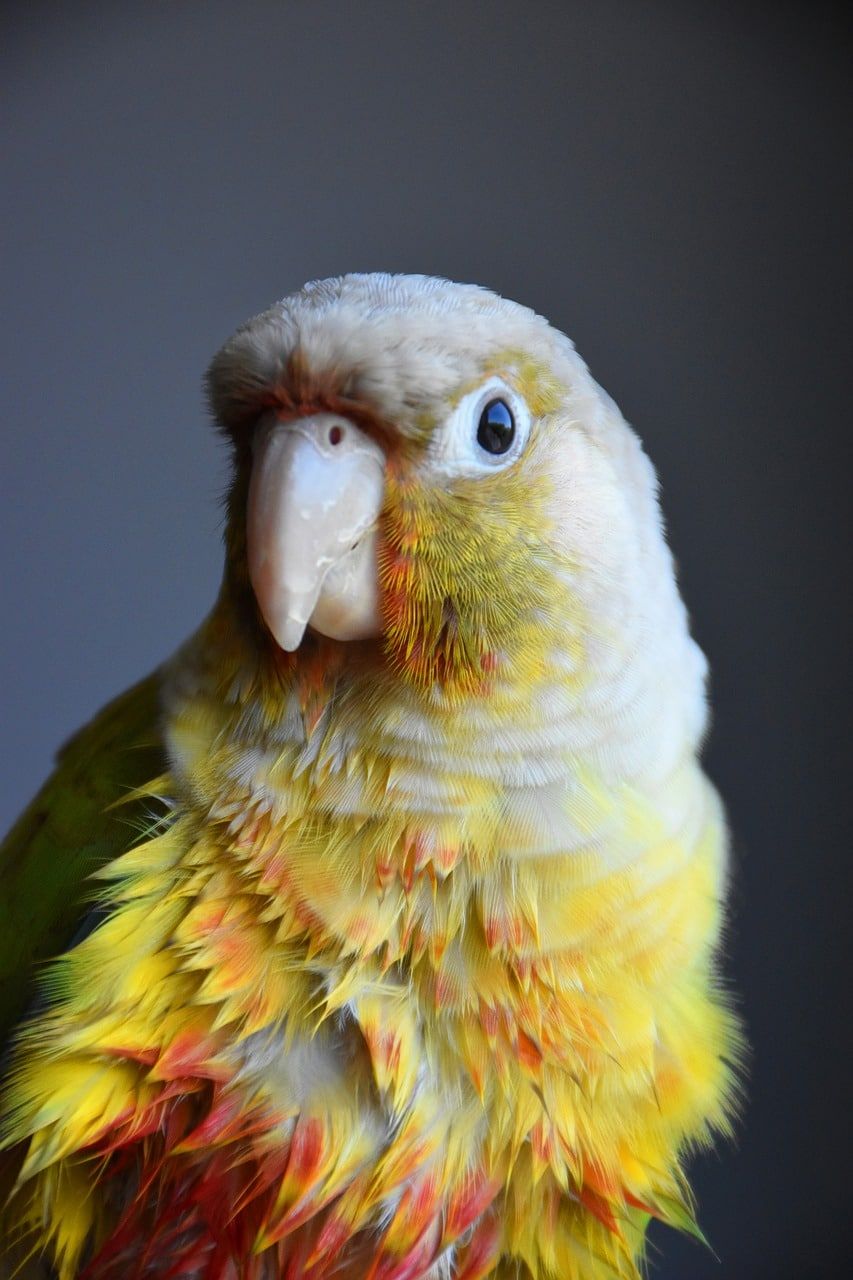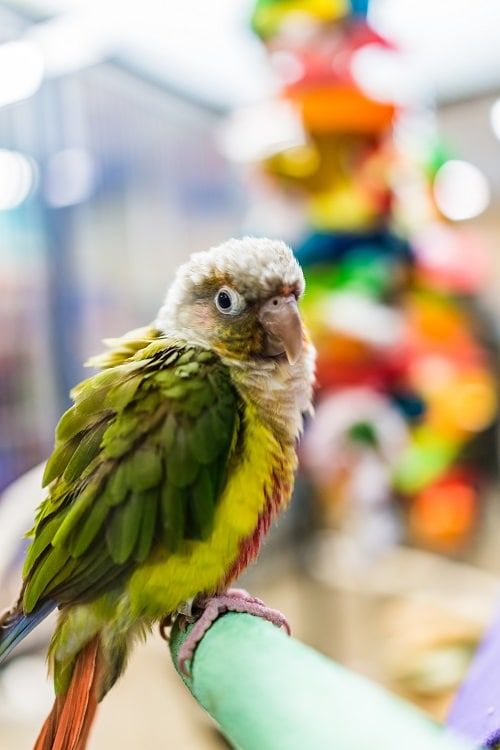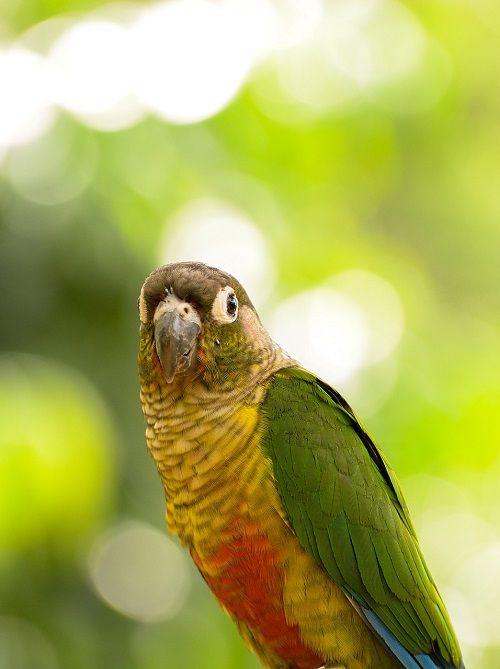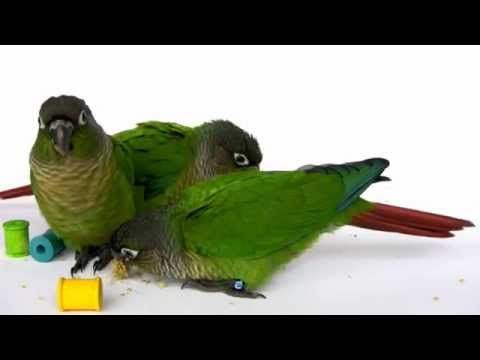If you’re thinking of adding a green cheek conure (Pyrrhura molinae) to your family, you might be wondering about green cheek conure lifespan. How long do green cheek conures live?
Let’s go into green cheek conure lifespan in the wild and in captivity, as well as the factors that play a part in making sure that yours lives a long and happy life.
This post contains affiliate links. If you make a purchase, a small percentage will go directly to Psittacology at no additional cost to you. Thank you for supporting Psittacology!
How long do green cheek conures live in the wild?
Also known as green-cheeked parakeet, the green cheek conure is a small parrot species that naturally occurs in South America. It’s scientifically known as Pyrrhura molinae and can be divided into six subspecies that can be told apart by their differing colors.
You’ll find the green cheek conure in treetop-dwelling flocks that inhabit forests in a geographical range that includes parts of Paraguay, Brazil, Bolivia and Northwestern Argentina.
As you can imagine, wild green cheek conures don’t live the cushy life that their domestic counterparts do. Although they stick to the treetops to reduce the chances of being snatched up by natural predators, they don’t have the potential lifespan of our pet birds.
A lucky wild green cheek conure will live between 10 to 15 years.

How long do green cheek conures live in captivity?
Logically, the potential lifespan of a captive green cheek conure is a lot better than that of a wild one. Note, though, that we’re talking potential lifespan.
Before we go into the numbers, I’d like to stress as always that how long your pet green cheek conure lives depends entirely on you. If you want the bird to live a long and happy life, it’s crucial to make sure you do plenty of research before you get one. In fact, you should never stop trying to learn more!
Before you buy a green cheek conure, you’ll have to make sure you’re prepared for the bird to be around for a very long time. Although bad husbandry leads many of these parakeets to pass away before they reach 10 years of age, green cheek conure lifespan actually stretches way beyond that. A well-cared for green cheek can easily make it to 20. In lucky cases, yours can actually be around for up to 30 years.
As you can imagine, it’s important to make sure that your situation and home life are stable before you add a green cheek conure to your family.

What influences green cheek conure lifespan?
So, as we’ve now established, green cheek conures have an amazing potential lifespan. But how do you ensure your bird has the chance to actually live for 30 years?
First off, it’s important to keep in mind that for some birds it’s just not meant to be. Just like humans, they can have genetic defects. Some of these can unfortunately mean they will never make it past a few years. They can fall ill to all sorts of diseases. Some are preventable with quarantine and proper care, but sometimes there’s just nothing you can do.
There’s obviously no reason to beat yourself up over your green cheek conure passing away from hereditary issues and other incurable conditions. Beyond that, though, there is a lot you can do to prevent your bird from succumbing prematurely due to illness or accidents.
Diet
One of the most important factors in keeping any domestic bird healthy is diet. This is, however, unfortunately also the part where the most mistakes occur. A balanced, suitable diet is very important for your green cheek conure but sadly, many sources don’t provide accurate info on what these birds are actually supposed to eat.
Wild green cheek conures will spend much of the day foraging for any tasty morsels they can find. Unlike cockatiels, for example, they’re not ground foragers; they prefer to stick to what can be found in the treetops. That includes fruits and seeds as well as any veggies they come across. Even insects aren’t safe from a green cheek conures hungry beak, although the birds won’t actively go out looking for them.
Wild green cheeks live a very active lifestyle and need a lot of calories to maintain a healthy weight. Their diet is high in fruit, as this contains sugar to provide plenty of energy. In captivity the situation is a bit different.
Even if your conure spends most of the day outside of its cage, it still needs less food than its wild counterpart. Fruits especially should be limited due to their sugar content. So should seeds, which are the traditional choice but high in fats.
So what comprises a healthy green cheek diet? Try a mix of the following:
- Fresh veggies and leafy greens
- Fresh fruits
- High-quality pellet mix
- High-quality seed mix
- Sprouted seeds (super easy to do yourself!) and select garden weeds such as clover
- Unsalted pasta, rice, lentils
- Treats: occasional nuts or millet (handy as training treats)
Keep in mind: fresh water should always be available, preferably multiple sources. Change water daily or whenever debris like poop or food has fallen into the bowl.

Stress prevention
Let’s take a moment to go into one very important factor in the lifespan of any living being. As you’re probably aware, stress can be incredibly unhealthy to humans. This is no different for pet birds like your green cheek conure.
You should always be mindful of environmental elements that can stress out a bird, as continued stress can take years off green cheek conure lifespan.
Some potential stress factors that you should aim to avoid are:
- Small cage/no out-of-cage time. Not just a big factor in causing obesity and related issues: not being able to move around is also very stressful for the bird!
- Lack of stimulation. Your bird needs toys and things to explore. If you aren’t able to spend multiple hours a day with it, it’ll also need company to keep it occupied.
- Rough handling. It can be frustrating when you just want to cuddle your green cheek but it’s not tame enough to allow it. However, you should never force interaction. Always stop if the bird shows signs of stress or wanting to get away.
- Feeling unsafe. Even if your green cheek conure is safe and sound inside its cage, it should not be exposed to anything that it might perceive as a predator. Always approach it gently and never let predator animals such as dogs or cats near the cage.

General care
Aside from offering high-quality, varied foods and avoiding stress factors, there are some additional care guidelines that you should always keep in mind. Green cheek conures are endlessly curious and can easily get themselves into sticky situations.
- Avoiding obesity. As mentioned earlier, a large cage and preferably plenty of out of cage time are important. Obesity is just as much of a killer in birds as it is in humans!
Keep your conure fit by letting it spend plenty of time outside of its cage and providing lots of parrot toys for it to play with.
- Safety. Anything and everything that your green cheek conure can reach needs to be bird proofed. Unsafe toys, open windows and hungry cats or dogs have killed many an unlucky conure.
Although sometimes an accident can happen completely unexpectedly, there is a lot you can do in terms of avoiding danger.
- Fumes. Like all domestic birds, green cheek conures have incredibly sensitive lungs. Dangerous fumes go beyond the obvious types (like cigarette smoke and pesticides): they also include things you might not think of.
Non-stick pans emit fumes that can be fatal to a parrot and so do (scented) candles, scented oil burners, cosmetics like hairspray or perfume and air freshener. We know birds can be stinky but unfortunately you can’t cover up the smell with commercial scented products!
- Quarantine and check ups. All new birds should be checked by a vet before they’re brought into your home to make sure they’re healthy. Not all diseases can be diagnosed easily, though, so you should also quarantine new additions for your other birds’ safety.
After that, your green cheek conure should be checked by an avian vet whenever anything appears amiss and ideally every year or so just to be sure.
- Emergency care and knowledge. Do you know what to do when your green cheek conure is bleeding? Do you have the tools in your home to remove a wood splinter lodged in the bird’s beak or foot?
We don’t want to think about emergencies, but it’s very important to be able to act quickly when serious problems strike.
How old is my green cheek conure?
If you rescued your green cheek conure (yay you!) or got it from a pet store that wasn’t able to give you any information regarding the bird’s age, you might be wondering how old it is.
Unfortunately, beyond the juvenile stage, there is really no way to figure out a green cheek conure’s age. You can check whether the bird has a leg band as this will sometimes contain info on when it hatched, but if there is no band and the bird is older than a few months you’re pretty much out of luck.
A very young baby green cheek conure is easy to recognize, as its feathers won’t have grown in yet. Loads of sheathed feathers and fluff are a good indication that the bird is only a few weeks old. After all feathers have grown in, things become really difficult.
Young birds that are no more than a few months old, like the ones in the video above, might be smaller and clumsier. Their feet will look more pristine and don’t have as much scaling and wear, but that’s really it. Bummer!
If you have any more questions about green cheek conure lifespan or want to share your own experiences with these ever so lovable South American parakeets, don’t hesitate to leave a comment below!


My Green Cheek is 19 years old! We got her (saved her) from a person (smoke infested house) when she was 10 months old. She’s happy, healthy, and active!
So she’s been with you for 18 years?! That’s amazing ♥
My Willy I rescued from a smoker, but sadly he died a year later in my arms.
I’m happy yours found a new home and a long life
I’m sorry to hear that, but stellar job on the rescue. I’m sure that last year was a happy one 🙂
My Green Cheek just turned 22 years old. His name is Ernie and I’ve had him since he was 6 months old. He traveled with me on a show circuit for many years (in a small airplane!). His cage is a very large plexiglass A-frame hand built for him and no front door. He’s happy and healthy and the personality of the household!!
Happy late birthday Ernie! On to the big 30!
we dont know her age for sure but have traced her back to second owner and accounted for 28 yrs. we dont know how long they had her. we only know that she is large and some feel she has been cross breed. i would really like to know about senior care and changes to expect ?
I saw your post on FB. Gorgeous bird, but yeah, I can’t immediately tell what she is either.
As for changes to expect, as you can probably guess, they just become slower and less agile. They might like wider, flatter perches and having access to a heat lamp or pad. You might need to feed a bit less as they start moving less, though be sure to still feed a healthy diet and try to encourage exercise (maybe not flying, but climbing etc.).
Other than that, just keep a very close eye on them: you know what their normal behavior is like, what a healthy poop looks like, what their weight should be, so look out for any changes. Common issues include cataracts, feather loss and arthritis. Regular vet visits are obviously a good idea.
I hope that helps, and I hope you’ll get to enjoy her for a good few more years. 🙂
I have two green cheeks .Boy was born (hatched) in August 1996 and the girl in 2003. They are both doing just fine. He seems a little bit lazier then he used to be. I think he also might have a slight case of arthritis ? But then ,maybe not . When I bring them something to eat, he is incredibly fast. The girl still acts like a youngster.
Paul
Thanks for sharing! Your boy is just a few months younger than me, haha. If you haven’t, you could always take the boy to the vet to have him checked for arthritis. Would be a good idea to do regular check-ups anyway given his age 🙂
Thanks Mari ! I am not so sure ,if he has an arthritis or not. Sometime ,like two years ago he had a slight problem with his right leg, but now he is doing just fine. I don’t know what it was ? It just went away. You are absolutely right. I should take him to the vet for a checkup. On the other hand I hate to stress him out ,unless it is absolutely necessary.
They are both enjoying on chewing and otherwise “remodeling” a smaller package Amazon cardboard box ,that’s hanging in their big cage. A box usually lasts three weeks before complete destruction.
It is my opinion ,that it’s not a bad idea to keep these in pair. They keep each other company when no one is home and like their human just as much as if kept single.
I understand the struggle of not wanting to stress them out vs going for regular check-ups. Although mine always seem fine, a bit miffed at first but then straight back to their cuddly selves. Nice to hear they’re happy and chewing! Wooden clothespins are a favorite here. And yes, you’re right, I’m a big fan of not keeping parrots alone unless you work from home or something like that. I do work from home (permanently) and I’m still keeping my eye out for a rescue cockatiel as company for my boy.
I have a brother and a sister they hatched the same date can I breed them .? They were born august 2019
This article provides a lot of info on inbreeding parrots. It’s generally frowned upon by hobbyists but it’s not uncommon for breeders looking for desirable traits to inbreed their birds. Unless you’re working on stabilizing a specific line, I wouldn’t go ahead with it myself. Also keep in mind that breeding parrots is a LOT of responsibility and it’s not really something I recommend for the casual bird owner who just wants to see how it is/what will happen.
We got our little girl at 6 months old. She has just turned 10 years old . She is the joy of our lives. She has traveled across canada and back . She is a very happy little girl 🙂
Thanks for sharing! I hope you guys enjoy many happy years together 🙂
We had our Teka for 23 years. The prior owners did not care for it so we don’t know how old it was when we got it. But 23 wonderful chirpy years! Sadly, it passed today. Missing my handsome boy.
I’m sorry to hear that, I guess you came to this article looking to see if 23 years is a long life for a conure. As you’ve concluded, it is! Glad to hear you guys got so many happy years together 🙂
Ours is 22, I believe a male. He’s an only bird but I’ve always been home. He’s pretty good but he started acting big and biting us after his first big molt, so he’s not handled a lot. He has a large cage and seems happy. He’s learned a lot of words I think 22 or so. Seems he’s forgetting a few the last year. He loves to mimic sounds and does a lot of them. The beep on the microwave, pills in a bottle, the pssst from a soda can when the top is popped. He yells at the dogs to stopit stopit when they start barking. Says Goodmorning babe, Nini, whatchadoingbabe, what’s up really loud when it gets to quiet and others.
Sounds like a wonderful little guy to have around even if he’s a little feisty 🙂 Thanks for sharing!
My little Fremont is going to be 14 in March! He’s been with me since a week after his first birthday and he’s been a doll. He was DNA tested as male after I got him. He’s my one and only bird and lives in a large wire cage I found on the side of the road a few years ago. I was so surprised to see it there with a FREE sign on it- I had to check to make sure the bars weren’t too wide (nope!) and sanitized it and set it up. He loves wandering around in it when he isn’t out with me.
I thought I would lose him when he turned nine due to a nail trimming accident, but he pulled through and has no lasting trauma except for a missing toe.
One quirk of him: he does NOT like too hard wood toys. Only the softest basal wood. Little chicken, please chew on wood for your beak! But no- only the softest hahaha he also absolutely loves bells.
I loved reading all of this! It’s been an age since I last read up on GCC care <3 Always learning!
Thanks for sharing! As I hope you’ve concluded, with some luck, you guys will be able to spend many more shenanigan-filled years together. 🙂
My GCC Iko was 22 on March 5, 2023. I acquired him from a breeder once he was weaned at 6 weeks. We’ve been through a lot together, but we’re still here.
He doesn’t eat millet anymore and a few other dietary changes. He has visible bluish cataracts so his sight isn’t as good as it used to be. Sadly, he’s been plucking 😢
He’s not a cuddly guy, but he’s very responsive to attention. He still likes learning new words and he likes music. I love him, and I take good care of him. Hopefully we have some good years left, we might be in the same stage of life, as I am in my Golden Years as well.
Happy belated birthday Iko! Sorry about his plucking. You could try taking him to the vet, because they do sometimes begin to pluck due to nutritional imbalances or other issues that can be resolved. Hope you guys can enjoy many more happy years together 🙂
I got my GCC in 2004, and hand fed him with an eye dropper. He slept on the pillow next to me (not recommended ever). Two days ago, he shot out the back door that was opened briefly, and soared like I have never seen. He could only fly about 10 feet without having to land. High over the houses and gone, just like that. No luck in finding him. My guess is he hunkered down in a tree top. Bad storm the same evening. Put his cage out back for the next 2 days, but they have no clue where they live. I just wonder if he wasn’t taking one shot at freedom before it was his time. Lost a great companion at 19. His name was Porky Porkchop.
Thanks for sharing. So sorry about Porky. If you haven’t tried already, play some green cheek conure sounds near his cage, although it’s unlikely he’s anywhere close. The wind just picks them up.
Since it wouldn’t hurt to try, don’t forget to post in local community FB groups if you haven’t already – I have heard of folks’ birds being found, and friends of mine have found birds and tracked down the owners this way. Good luck!
Hi, my GCC is 10 years old. Ive had her since she was 6 months. She was injured when she was 1 year and as a result has pain in her right leg at times. The doctor prescribed metacam which is very strong and can be fatal when used too much so I started giving her black seed cumin in very small amounts as needed and it worked!! Still using it for her a few times weekly.
Shes with me 24 hours a day and I dont know what I would do without her. She lives on my shoulders, perch, and sleeps in a cage with her own bed at night. Thanks for taking time to share your knowledge on this site.😊😙
Thank you for sharing, happy to hear she’s doing well. Enjoy many more happy years together! 🙂